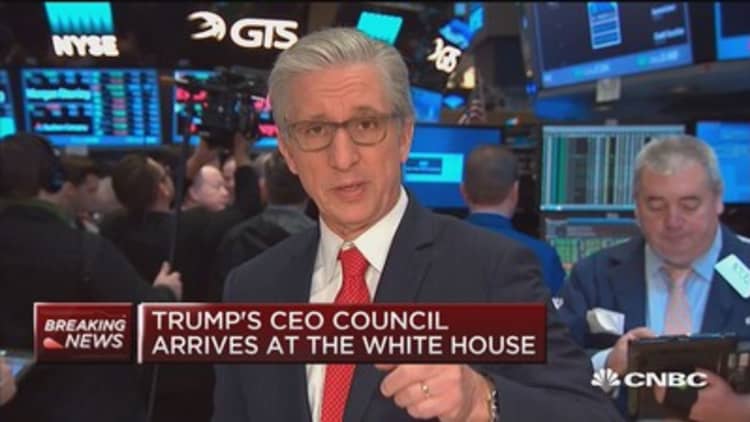
U.S. equities rallied on Friday, with financials rising around 2 percent, following a stronger-than-expected employment report.
The Dow Jones industrial average jumped around 180 points — posting its best trading day of the year — with Goldman Sachs contributed the most gains. The S&P 500 rose 0.7 percent, with financials leading advancers. The Nasdaq composite gained 0.5 percent and closed at a record high.
The U.S. economy added 227,000 jobs in January, while the unemployment rate ticked higher to 4.8 percent, the Bureau of Labor Statistics said Friday. Economists polled by Reuters expected payrolls to grow by 175,000 with the unemployment rate holding steady.
"I think the jobs report, although wage growth was not where people wanted to be, was pretty good," said JJ Kinahan, chief market strategist at TD Ameritrade. He also said jobs growth in construction and health care were two positives from the report.
Average hourly earnings, however, rose just 3 cents and 2.5 percent on an annualized basis. The average work week was unchanged at 34.4 hours.
"Here's the good: It's better than expected and much better on the private payrolls," said Art Hogan, chief market strategist at Wunderlich Securities, adding the labor force participation rate also rose slightly. "When you see the unemployment rate go higher for the right reason, that's a positive."
The report was "what the Fed needs, but the wages growth was weaker than expected," said Quincy Krosby, market strategist at Prudential Financial. "When you have an economy that is so dependent on consumer, wages are very important."
U.S. Treasurys whipsawed following the report's release, with the benchmark 10-year note yield last rising to 2.47 percent, while the short-term two-year note yield held near 1.1205 percent. "Had wages moved [further] higher, the 10-year yield have moved above 2.5 percent," said Prudential's Krosby.
"What Treasury yields are responding to is are mostly inflation expectations," said Scott Kimball, portfolio manager, BMO TCH Core Plus Bond Fund, adding he thinks the overall trend in yields is to the upside, but investors should not expect them to return to historical levels.
The Federal Reserve held its first monetary policy meeting this week and opted to keep interest rates unchanged.
Craig Bishop, vice president of U.S. fixed income at RBC Wealth Management, said Friday's jobs report should keep the Fed on a moderate normalization path. "We had two really solid numbers in the headline and participation rate, but there wasn't anything else to write home about," he said. "I think the trend in wages overall is higher, but not enough to increase inflation."
The report was the first since President Donald Trump took office on Jan. 20. In the past, Trump has been critical of the unemployment rate, saying it understates the actual level of joblessness.
Other data released Friday included December factory orders, which rose 1.3 percent, and the January read on the ISM nonmanufacturing index, which came in at 56.5, slightly below December's 56.6.
The three major indexes entered Friday's session on track to post weekly losses amid uncertainty surrounding some of Trump's policies, particularly an executive order barring entry into the U.S. to citizens from seven Muslim-majority countries.
On Friday, however, Trump signed executive orders aimed at watering down financial regulations in the U.S., lifting theFinancial Select Sector SPDR Fund (XLF) by 2 percent.
"We're in the middle of a huge structural change in the market," said TD Ameritrade's Kinahan. "For the past few years, we were a Fed-driven market; now we're a policy driven market."
Overseas, European equities rose broadly, with the Stoxx 600 index rising 0.6 percent. In Asia, Chinese equities closed lower after the week-long break from the Chinese New Year holiday, with the Shanghai composite falling 0.59 percent.
Major U.S. Indexes
The Dow Jones industrial average gained 186.55 points, or 0.94 percent, to end at 20,071.46, with Visa leading advancers and NIke the top decliner.
The rose 16.57 points, or 0.73 percent, to end at 2,297, with financials leading 10 sectors higher and consumer discretionary the only laggard.
The Nasdaq composite advanced 30.57 points, or 0.54 percent, to close at 5,666.77.
About four stocks advanced for every decliner at the New York Stock Exchange, with an exchange volume of 851.47 million and a composite volume of 3.575 billion at the close.
The CBOE Volatility Index (VIX), widely considered the best gauge of fear in the market, traded near 10.81.
High-frequency trading accounted for 52 percent of February's daily trading volume of about 7.34 billion shares, according to TABB Group. During the peak levels of high-frequency trading in 2009, about 61 percent of 9.8 billion of average daily shares traded were executed by high-frequency traders.
U.S. oil futures for March delivery rose 29 cents to settle at $53.83 per barrel. Gold futures for April delivery rose $1.40 to settle at $1,220.80 per ounce.
—CNBC's Jeff Cox contributed to this report.


